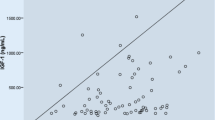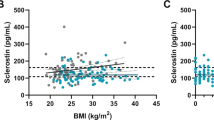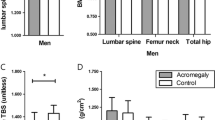Abstract:
Acromegaly caused by growth hormone (GH) hypersecretion is characterized by enhanced skeletal growth and soft tissue enlargement. Insulin-like growth factor-1 (IGF-1) is the main peripheral mediator of GH action and it has a crucial role in the maintenance of a normal bone mass. However, in some patients with acromegaly, secondary osteoporosis is observed, despite the strong anabolic effect of GH and IGF-1 in bones. It is thought to be due to hypogonadism. The bone changes are accompanied by increased turnover. The aim of this study was to assess bone properties by ultrasound and turnover in patients with acromegaly. The study was carried out in 26 patients (13 men, 13 women): 14 with active acromegaly and 12 cured by surgery who had non-active disease. Speed of sound (SOS), broadband ultrasound attenuation (BUA) and their combination Stiffness Index (SI) by quantitative ultrasound (QUS) of the heel, hormonal status, serum osteocalcin (OC) concentration and the urinary excretion of pyridinoline collagen crosslinks (PYR) were all studied. Controls were 20 age- and sex-matched healthy persons. We observed statistically significantly lower QUS values in patients with active disease than in those whose disease was cured. The differences were more pronounced in men. QUS values were lower in the entire group of patients compared with the controls; however, the differences were not statistically significant. Serum OC concentrations and urinary PYR excretion were higher in active disease. Statistically significant inverse correlations between serum GH levels and SOS (r=–0.58, p = 0.002); BUA (r=–0.66; p= 0.0001); T-score (r = −0,65, p= 0.0001) and Z-score (r=–0.66, p = 0.0001) were found only in male patients. No correlations between IGF-1, duration of the disease, OC, PYR and other data studied were observed. In conclusion, we have shown decreased QUS parameters suggesting impaired bone properties and quality in terms of density and elasticity in men, but not in women, with active acromegaly. This finding suggests osteoporosis with increased bone turnover. The above-mentioned changes might be caused by the action of GH on trabecular bone and its metabolism, since no hypogonadism in male patients was shown. Moreover, the influence of acromegaly on heel geometry and soft tissue swelling should also be considered.
Similar content being viewed by others
Author information
Authors and Affiliations
Additional information
Received: 20 February 2001 / Accepted: 23 October 2001
Rights and permissions
About this article
Cite this article
Bolanowski, M., Jędrzejuk, D., Milewicz, A. et al. Quantitative Ultrasound of the Heel and Some Parameters of Bone Turnover in Patients with Acromegaly . Osteoporos Int 13, 303–308 (2002). https://doi.org/10.1007/s001980200030
Published:
Issue Date:
DOI: https://doi.org/10.1007/s001980200030




